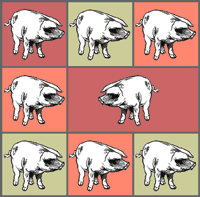the pig is investigated in all the ages of the world’s art
Art is self-perception, not reality… If hogs could paint, they would paint gods that look like hogs.
Porculus, (327 – 291 BC),
from The Pigaleian (276 BC).

At the Porkopolis Museum of Art, the pig is investigated as a frequent figure in all the ages of the world’s art. The collection is illustrative of how artists have attempted to represent the varied forms and functions that the pig has fulfilled throughout his long association with man.
It has been asserted that pigs, like all creatures, were not created and formed for themselves only, but also for the sake of their fellow creatures, all being born obliged to be of use and service to one another.
Certainly the human view of this assertion has often erred toward our own self-interest, viewed in the single direction of the use and utility of pigs to man alone.
Yet over time and across cultures, the needs and the judgments of people vary so widely, and each goes his own way, art being but an invention of these various ways.
And thus the art works on display here are intended to provide visitors with an additional ingredient in our understanding of the usefulness of pigs; and what our association with the pig – as food source, companion, and symbol – has contributed to human interpretation and appreciation of life and reality.

